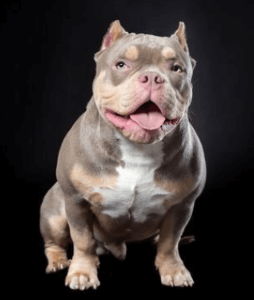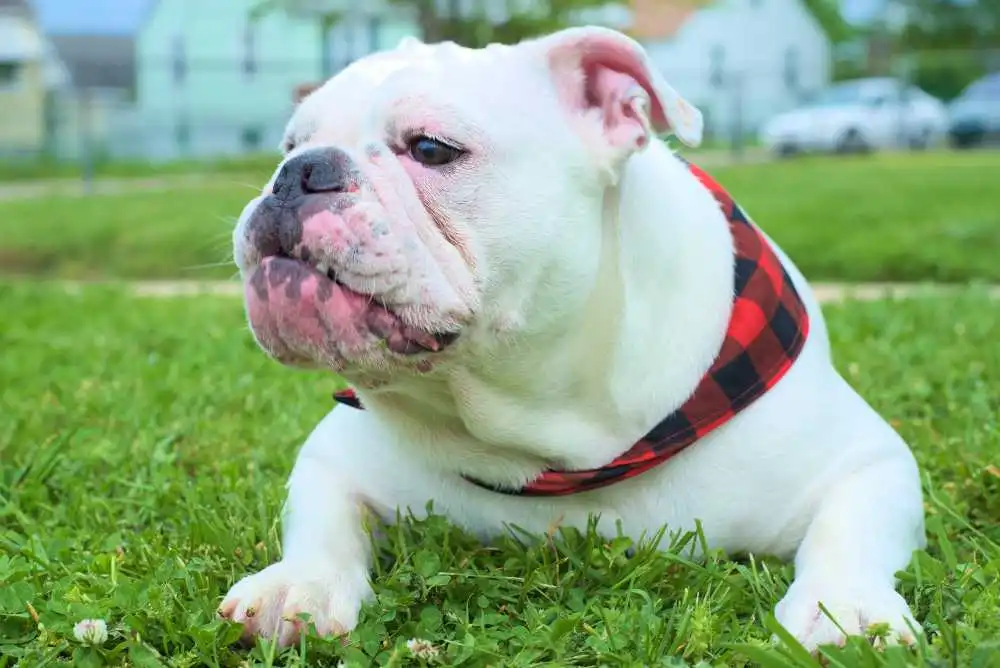Did you know that one of the most striking and sought-after variations of the American Bully breed is the Tri-Colored Bully? This distinct breed, known for its unique and captivating coat pattern, has been making waves in the pet world for its aesthetic appeal and vibrant personality. The American Bully is a breed full of diversity, boasting a spectrum of fascinating color combinations that are as varied as they are beautiful. Among the most visually striking is the Tri-Colored variation, a breed that has captured the hearts of many dog enthusiasts.
What is a Tri-Colored Bully?
A tri-colored bully typically refers to a specific color pattern in a certain dog breed. This unique color combination can be found in American bullies, who exhibit different coat colors and patterns. Tri-colored bullies feature three coat colors- a base color with underlying white and tan points. The base color can be either black, blue, or lilac. To understand its tri-colored pattern, you must know the factors determining the dog’s coat color.
Each hair follicle in a tri-colored bully has melanocyte cells that produce melanin. The more melanin, the darker the coat will appear. The agouti (A) locus is responsible for color variation in tri-colored bullies.
The Different Variants
It’s worth noting that the specific colors and patterns in a tri-colored bully can vary widely within each variation. Many colors and patterns can appear in tri-colored bullies. Ultimately, the exact appearance of a tri-color bully will depend on their genetics and breeding.
The tri-color bully has several variations, depending on their coats’ specific colors and patterns. Some common tri-bully variations include:
- Blue – A blue tri bully has a distinctive blue coat with patches of tan or brown markings. The blue tri bully is striking, contrasting their blue coat against the lighter tan or brown markings. Their blue color is a diluted form of the black color gene. Like other variants of Tri colored bullies, the blue tri bully has a muscular build, a broad chest, and a short, glossy coat.
- Tri Merle- The merle tri color bully has a merle coat pattern with three distinct colors. Merle is a pattern characterized by random patches of color on a lighter background, including black, brown, blue, or red. A tri-merle bully has a white base coat.
- Black- A black tri bully has a black coat with patches of brown markings. The black coat contrasting with the brown markings makes the black Tri bully look striking.
- Choco- This tri-bully has a chocolate coat with patches of tan. The chocolate color in these dogs is a result of the expression of the recessive gene responsible for the brown coat color. They are family-friendly and very affectionate.
- Lilac- The lilac color in lilac tri-bully results from the expression of the recessive gene responsible for the dilution of the chocolate color gene. Lilac tri bullies are characterized by a unique light purple coat contrasting against the brown markings.
- Brindle- This tri-bully combines a brindle pattern with a tan point that is good-looking but rare. The brindle pattern incorporates a brown base with dark stripes.
- Piebald- A mixture of white and black coat colors characterizes the Piebald tri-color bully. The markings are present in a third color.
- Ghost- Ghost tri-color bullies lack the dominant black gene, resulting in a dilute coat, giving the dogs their “ghostly” transparent look.
Unlike the other tri-colored bullies, the merle tri-bully has either blue eyes or one blue and one brown eye. This is because the merle gene is associated with eye color that dilutes the eyes. While the merle pattern is visually striking, some research suggests that the merle gene is linked with deafness and poor health. Due to this reason, the American Kennel Club (AKC) does not recognize the tri-merle bully.
What Colors Are the Most Popular?
Although the popularity of tri-colored bullies is increasing, these dogs are still uncommon. They are uncommon because most breeders and uninformed public members consider a tri-colored bully a mixed breed.
Therefore, they are rarely bred as most buyers prefer dogs they consider purebred. The misconception that tri-colored bullies are a mixed breed has led many people to view them as undesirable.
Additionally, many breeders rely more on the game qualities than the original sires’ coat color. Thus, the sires rarely produce tri-colored bullies because the offspring’s coat color does not appear naturally.
Breeding for the tri-colored bully offspring is complicated because some genes are recessive. This means the breeder requires much effort to produce a tri-colored bully. When it comes to color, some combinations are rarer than others. The most popular colors of tri bullies are black, brown, and fawn. Although some have lilac and blue colors, they are uncommon.
How Are American Tri Color Bullies Different from Other Bullies
While tri-colored bullies and other bullies are all loyal canine companions, they have notable differences in nature. Some dog enthusiasts fancy the tri-color bully, while others prefer the other bullies. It all narrows down to one’s choice and preference.
Their physique is the sole difference from other bullies. The color and pattern of their coats are different from each other. Since their personality and temperament are the same, there are no other significant differences between tri-colored and normal bullies. All bullies are ideal companions and are tolerant of strangers and children. Despite tri-colored bullies’ distinctive appearance, they are not considered a separate breed from other bullies.
What Breed is a Tri Bully?
A tri-colored bully is a mix of three different bully breeds. The American Pitbull Terrier, the American Bully, and the American Staffordshire Terrier. Breeders selectively breed these dogs to obtain all the desirable traits. All parents must pass on a particular gene for the offspring to inherit a tri-color coat. It’s worth noting that the tri-color gene is a recessive trait. Therefore, breeders must go to great lengths to pick the parents selectively.
It could take a breeder several generations to obtain the specific variant of a tri-colored bully they desire. The tri-colored bullies are commonly sought after because of their unique coloration, so color is the factor to consider while breeding.
Breeders consider various things while pairing parents to produce a desirable tri-colored bully. The Agouti gene is responsible for the offspring’s color and pattern. Depending on the sire’s Agouti genes, these will likely be the offspring’s coat colors.
- A gene– Results in blue, black, or chocolate color variations. Black is mostly the dominant color in this case.
- Ay, gene– Yellow is likely to become the dominant color.
- At gene– Results to solid-colored bullies because this gene is recessive. In this case, brown is dominant.
The sires have red and black pigments in their coats that form melanin. The agouti gene regulates the interaction of the red and black pigments in the dog’s coat. Therefore, the offspring acquires a proper placement of three colors that are mutually proportionate.
The gene responsible for the offspring’s color is known as an allele. Each parent passes on one allele to the offspring.
It’s important to note that breed-specific laws and regulations may vary depending on your location. Always research and understand any restrictions before considering owning this dog breed.
Is a Tri-Color Bully a PitBull?

Photo: Alamy
A tri-colored bully is technically not a pit bull but a distinct breed in its own right. Several breeds produce the tri-colored bully, sharing some physical and behavioral characteristics.
The American Kennel Club recognizes only different dog breeds as pit bulls. The four are:
- American Bully
- Staffordshire Bull Terrier
- American Staffordshire Terrier
- American Pit Bull Terrier
While the tri-colored bully originates from the above breeds, calling it a pit bull gives an incomplete picture. The fact that tri-colored bullies are originally bred from pit bulls does not make them the same breed.
Unlike Tri-colored bullies, pit bulls are known to be dangerous and aggressive. However, this is only sometimes the case as it narrows down to how they are raised and trained.
How Much is a Tri Bully Worth?
How much a tri-colored bully puppy is worth depends on several factors. The factors may include the following:
- The bloodline
- Breeder’s reputation
- Size
- Build
- The color and pattern
For different reasons, breeders do not value their puppies the same. They can go as high or as low as they want with their pricing. The table below showcases price estimates for different tri-colored bully puppies.
| Choco Tri Bully Puppy | $5000-$7000 |
| Black Tri Bully Puppy | $4000-$6000 |
| Brindle Tri Bully Puppy | $6000-$8000 |
| Blue Tri Bully Puppy | $5000-$7000 |
| Lilac Tri Bully Puppy | $8000-$12000 |
| Ghost Tri Bully Puppy | $10000-$15000 |
| Piebald Tri Bully Puppy | $6000-$8000 |
The price significantly varies due to the differences in the coat color combination.
Facts About this Breed
The tri-color American bully is an American dog with three visible coat colors. Before breeding for a tri-color American bully, there are crucial considerations and facts to note. Below are some facts about the tri-color American bully:
Temperament
Like any other bully breed, the tri-color American bully exhibits an energetic, friendly, and playful dog character. It is friendly to humans and makes a good companion. Due to their intelligence, the American bullies will respect and please you. They are also adaptable and competent in performing various tasks. Furthermore, tri-colored bullies can combat their aggression and remain tolerant while in pain.
Coat
Besides color, the Tricolor American bullies exhibit short, fine, smooth, and glossy coats. The shortness and fineness of the coats make it easy to take care of these dogs. The coat is low maintenance and easy to gloom.
Additionally, these dogs shed less. You will have to worry about having fur all over. The only coat-related shortcoming that American bullies face is that cold weather significantly affects them. The short coat does not keep them warm enough.
Exercise
Tri-colored American bullies require a lot of exercise to stimulate their mental capability. Creating time to take your American bully for walks and runs helps burn off the excess energy. You can also opt to enroll your dog in dog sports.
Health Concerns
Although Tri-colored American bullies are generally healthy dogs, there are some potential health problems that you should be familiar with. Some health conditions that American bullies are susceptible to are:
- Hip dysplasia
- Elbow dysplasia
- Congenital heart disease
- Skin diseases, like eczema.
They may also suffer from allergies due to their short coat. Heart conditions, such as aortic stenosis and eye problems, including progressive retinal atrophy, are also known issues for this breed. As with all dogs, regular check-ups with a veterinarian can help catch and manage these health problems early. Additionally, ensure they follow proper nutrition.
Tolerance to Extreme Weather
Tri-colored American bullies are not very tolerant of extreme weather conditions. If you live in an area with harsh weather conditions, you should take extra care of your dog. You must provide your bully with water and shade during the hot weather and invest in a dog sweater during the cold weather.
How Big Do They Get?
The American Bully Kennel Club (ABKC) recognizes tri-colored bullies in four different sizes. All the varying sizes are outlined as follows:
- Pocket Bully- the pocket-sized bully has a muscular body with a substantial bone structure. Male bullies measure under 17″ while females measure less than 14″. Their overall weight is 20-65 pounds.
- Classic Bully- a narrow body structure defines the classic tri-colored bully. The body frame and the overall body mass are less despite the dog’s gender. Classic-sized male tri-colored bullies measure 17″-20″ while females measure 16 “-19”. The lifespan of classic bullies is 10 to 12 years, with an overall weight of 50-70 pounds.
- Standard Bully- standard bullies have compact and medium bodies. They have muscular bodies accompanied by blocky heads. Due to their substantial bone structure, standard bullies give an impression of extra strength proportional to their size. They weigh 65-85 pounds. Male standard bullies measure 17″-20″ while standard female bullies measure 16″-19″. These dogs’ lifespan is 10 to 12 years.
- XL Bully- the XL tri-colored bully is an amendment of the standard bully and the biggest of all the varying sizes. The only difference is that the XL bullies are taller, more muscular, bulkier, and more massive. Male XL bullies measure over 20″-23″ while females measure over “19-22”. Their average life expectancy is 10 to 12 years, but they can live more with proper care and attention. Their overall weight is 85 pounds and over.
Other types of tri-color bullies that exist are:
- The XXL American Bully is a larger breed version with a height of over 23″. The XXL American bullies have a lower life expectancy because their sizes add extra pressure on their joints, predisposing them to health issues.
- The Exotic Bully– They are smaller than the average pocket tri-colored bullies. They are a result of cross-breeding a Patterdale Terrier. Their size results in health issues and a shorter life span.
- Extreme Bully– These are the same size as the pocket bully but have extremely muscular heads, necks, and shoulders.
Training and Socializing
When it comes to training your Tri-Colored Bully, whether a puppy or an adult, different techniques are required. Puppies are sponges for learning, making this the ideal time to instill basic commands and manners. While still trainable, adults may require extra patience and consistency.
Regardless of their age, socializing with your Bully is crucial. Introducing them to various experiences, environments, and people can help shape them into well-rounded, confident dogs. Remember, positive reinforcement and obedience training are key regardless of age or stage. Like all Bully breeds, they respond best to a kind, firm, and consistent hand. Training isn’t simply about getting your dog to follow commands but building a bond based on trust and mutual respect.
Living with a Tri-Colored Bully: A Treasure Trove of Memories

Photo: Puppy Traveller
Living with a Tri-Colored Bully is like having a ray of sunshine in your home, even on the cloudiest of days. Their joyful energy, boundless charisma, and unconditional love make them the perfect family pets. They revel in the company of their family, whether it’s playing a game of fetch in the backyard or simply cuddling on the couch. Their loyalty and affection know no bounds, making every moment spent with them a memory to cherish.
However, these lovable giants come with their set of requirements. They are energetic and love their playtime, so they need ample space to move around and exercise. A small apartment might not be the best fit for them. They also have a zest for life and an adventurous streak, so they’re best suited to active lifestyles where they can enjoy the fun.
Finding a Tri-Colored Bully to join your family should always involve careful research and consideration. Always opt for reputable breeders who prioritize health, temperament, and breed standards over profit. These breeders will provide health clearances for both puppy’s parents, ensuring you bring home a healthy pup. Alternatively, adopting a Tri-Colored Bully can be a wonderful and rewarding option. Many Bullies in rescue centers are waiting for their forever homes and might just be waiting for you!
Preparing Your Home: A Checklist
Welcoming a Tri-Colored Bully into your home involves thoughtful preparation to ensure a safe, comfortable environment for your new family member. Start by securing your home and checking for potential hazards like loose wires, harmful substances, or small objects that could be a choking hazard. A well-fenced yard is ideal for their playtime, but ensure no gaps or holes where the dog could escape.
Invest in a high-quality, durable dog bed that can withstand the Bully’s robust play. A crate can also be useful for house training and provides a safe, quiet space for the dog to retreat. Remember, Tri-Colored Bullies are muscular dogs requiring sturdy toys that can withstand their powerful jaws.
Ensure you have a good stock of nutritious dog food appropriate for their age, size, and health status. You’ll also need food and water bowls, a collar, a leash, a harness for walks, and grooming tools such as a dog-specific toothbrush, nail clippers, and a brush for their short coat.
Lastly, don’t forget the poo bags for those necessary clean-ups during walks and a couple of chew toys to keep them occupied. By preparing your home systematically, you can ensure a smooth and happy transition for your Tri-Colored Bully into their new home.
5 Things You Need to Know
Bully breeds, also known as Bully dogs, are characterized by their muscular build and strong, powerful appearance. Here are five important things to know about bully breeds.
- Bully breeds are not specific breeds. They are a group of breeds with similar characteristics, such as muscular bodies, broad heads, and strong jaws. Some of the most common bully breeds include the American Pit Bull Terrier, Staffordshire Bull Terrier, and the American Bully.
- Most bully breeds were originally bred for dogfighting, which is now illegal in most countries. However, these breeds can only display aggressive behavior without proper training and socialization.
- Unfortunately, Breed-Specific Legislation (BSL) targets bully breeds. This organization seeks to ban the bully breed’s ownership in certain areas. This is due to their reputation for aggression, which is often undeserved.
- Despite their reputation, bully breeds can make great pets for the right owner. They are loyal, intelligent, and affectionate dogs that thrive on attention and love. Proper training and socialization are essential to ensure that Bully dogs are well-behaved and safe around people and other pets.
- Bully breeds are active dogs that require regular exercise to stay healthy and happy. Daily walks, playtime, and training sessions can help prevent destructive behavior and stimulate them mentally.
Take Away
A tri-colored bully is a great, loyal, intelligent fur friend who would be a great addition to your family. After learning everything about tri-colored bullies, I hope you have the confidence to go ahead and get one. You can read more about tri-colored bullies here.





